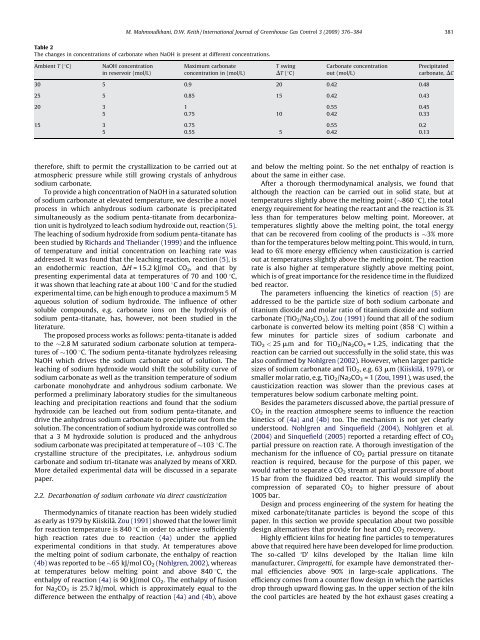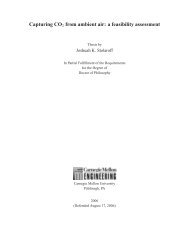Low-energy sodium hydroxide recovery for CO2 ... - David Keith
Low-energy sodium hydroxide recovery for CO2 ... - David Keith
Low-energy sodium hydroxide recovery for CO2 ... - David Keith
Create successful ePaper yourself
Turn your PDF publications into a flip-book with our unique Google optimized e-Paper software.
M. Mahmoudkhani, D.W. <strong>Keith</strong> / International Journal of Greenhouse Gas Control 3 (2009) 376–384 381<br />
Table 2<br />
The changes in concentrations of carbonate when NaOH is present at different concentrations.<br />
Ambient T (8C)<br />
NaOH concentration<br />
in reservoir (mol/L)<br />
Maximum carbonate<br />
concentration in (mol/L)<br />
T swing<br />
DT (8C)<br />
Carbonate concentration<br />
out (mol/L)<br />
Precipitated<br />
carbonate, DC<br />
30 5 0.9 20 0.42 0.48<br />
25 5 0.85 15 0.42 0.43<br />
20 3 1 0.55 0.45<br />
5 0.75 10 0.42 0.33<br />
15 3 0.75 0.55 0.2<br />
5 0.55 5 0.42 0.13<br />
there<strong>for</strong>e, shift to permit the crystallization to be carried out at<br />
atmospheric pressure while still growing crystals of anhydrous<br />
<strong>sodium</strong> carbonate.<br />
To provide a high concentration of NaOH in a saturated solution<br />
of <strong>sodium</strong> carbonate at elevated temperature, we describe a novel<br />
process in which anhydrous <strong>sodium</strong> carbonate is precipitated<br />
simultaneously as the <strong>sodium</strong> penta-titanate from decarbonization<br />
unit is hydrolyzed to leach <strong>sodium</strong> <strong>hydroxide</strong> out, reaction (5).<br />
The leaching of <strong>sodium</strong> <strong>hydroxide</strong> from <strong>sodium</strong> penta-titanate has<br />
been studied by Richards and Theliander (1999) and the influence<br />
of temperature and initial concentration on leaching rate was<br />
addressed. It was found that the leaching reaction, reaction (5), is<br />
an endothermic reaction, DH = 15.2 kJ/mol CO 2 , and that by<br />
presenting experimental data at temperatures of 70 and 100 8C,<br />
it was shown that leaching rate at about 100 8C and <strong>for</strong> the studied<br />
experimental time, can be high enough to produce a maximum 5 M<br />
aqueous solution of <strong>sodium</strong> <strong>hydroxide</strong>. The influence of other<br />
soluble compounds, e.g. carbonate ions on the hydrolysis of<br />
<strong>sodium</strong> penta-titanate, has, however, not been studied in the<br />
literature.<br />
The proposed process works as follows: penta-titanate is added<br />
to the 2.8 M saturated <strong>sodium</strong> carbonate solution at temperatures<br />
of 100 8C. The <strong>sodium</strong> penta-titanate hydrolyzes releasing<br />
NaOH which drives the <strong>sodium</strong> carbonate out of solution. The<br />
leaching of <strong>sodium</strong> <strong>hydroxide</strong> would shift the solubility curve of<br />
<strong>sodium</strong> carbonate as well as the transition temperature of <strong>sodium</strong><br />
carbonate monohydrate and anhydrous <strong>sodium</strong> carbonate. We<br />
per<strong>for</strong>med a preliminary laboratory studies <strong>for</strong> the simultaneous<br />
leaching and precipitation reactions and found that the <strong>sodium</strong><br />
<strong>hydroxide</strong> can be leached out from <strong>sodium</strong> penta-titanate, and<br />
drive the anhydrous <strong>sodium</strong> carbonate to precipitate out from the<br />
solution. The concentration of <strong>sodium</strong> <strong>hydroxide</strong> was controlled so<br />
that a 3 M <strong>hydroxide</strong> solution is produced and the anhydrous<br />
<strong>sodium</strong> carbonate was precipitated at temperature of 103 8C. The<br />
crystalline structure of the precipitates, i.e. anhydrous <strong>sodium</strong><br />
carbonate and <strong>sodium</strong> tri-titanate was analyzed by means of XRD.<br />
More detailed experimental data will be discussed in a separate<br />
paper.<br />
2.2. Decarbonation of <strong>sodium</strong> carbonate via direct causticization<br />
Thermodynamics of titanate reaction has been widely studied<br />
as early as 1979 by Kiiskilä. Zou (1991) showed that the lower limit<br />
<strong>for</strong> reaction temperature is 840 8C in order to achieve sufficiently<br />
high reaction rates due to reaction (4a) under the applied<br />
experimental conditions in that study. At temperatures above<br />
the melting point of <strong>sodium</strong> carbonate, the enthalpy of reaction<br />
(4b) was reported to be 65 kJ/mol CO 2 (Nohlgren, 2002), whereas<br />
at temperatures below melting point and above 840 8C, the<br />
enthalpy of reaction (4a) is 90 kJ/mol CO 2 . The enthalpy of fusion<br />
<strong>for</strong> Na 2 CO 3 is 25.7 kJ/mol, which is approximately equal to the<br />
difference between the enthalpy of reaction (4a) and (4b), above<br />
and below the melting point. So the net enthalpy of reaction is<br />
about the same in either case.<br />
After a thorough thermodynamical analysis, we found that<br />
although the reaction can be carried out in solid state, but at<br />
temperatures slightly above the melting point (860 8C), the total<br />
<strong>energy</strong> requirement <strong>for</strong> heating the reactant and the reaction is 3%<br />
less than <strong>for</strong> temperatures below melting point. Moreover, at<br />
temperatures slightly above the melting point, the total <strong>energy</strong><br />
that can be recovered from cooling of the products is 3% more<br />
than <strong>for</strong> the temperatures below melting point. This would, in turn,<br />
lead to 6% more <strong>energy</strong> efficiency when causticization is carried<br />
out at temperatures slightly above the melting point. The reaction<br />
rate is also higher at temperature slightly above melting point,<br />
which is of great importance <strong>for</strong> the residence time in the fluidized<br />
bed reactor.<br />
The parameters influencing the kinetics of reaction (5) are<br />
addressed to be the particle size of both <strong>sodium</strong> carbonate and<br />
titanium dioxide and molar ratio of titanium dioxide and <strong>sodium</strong><br />
carbonate (TiO 2 /Na 2 CO 3 ). Zou (1991) found that all of the <strong>sodium</strong><br />
carbonate is converted below its melting point (858 8C) within a<br />
few minutes <strong>for</strong> particle sizes of <strong>sodium</strong> carbonate and<br />
TiO 2 < 25 mm and <strong>for</strong> TiO 2 /Na 2 CO 3 = 1.25, indicating that the<br />
reaction can be carried out successfully in the solid state, this was<br />
also confirmed by Nohlgren (2002). However, when larger particle<br />
sizes of <strong>sodium</strong> carbonate and TiO 2 , e.g. 63 mm (Kiiskilä, 1979), or<br />
smaller molar ratio, e.g. TiO 2 /Na 2 CO 3 =1(Zou, 1991), was used, the<br />
causticization reaction was slower than the previous cases at<br />
temperatures below <strong>sodium</strong> carbonate melting point.<br />
Besides the parameters discussed above, the partial pressure of<br />
CO 2 in the reaction atmosphere seems to influence the reaction<br />
kinetics of (4a) and (4b) too. The mechanism is not yet clearly<br />
understood. Nohlgren and Sinquefield (2004), Nohlgren et al.<br />
(2004) and Sinquefield (2005) reported a retarding effect of CO 2<br />
partial pressure on reaction rate. A thorough investigation of the<br />
mechanism <strong>for</strong> the influence of CO 2 partial pressure on titanate<br />
reaction is required, because <strong>for</strong> the purpose of this paper, we<br />
would rather to separate a CO 2 stream at partial pressure of about<br />
15 bar from the fluidized bed reactor. This would simplify the<br />
compression of separated CO 2 to higher pressure of about<br />
1005 bar.<br />
Design and process engineering of the system <strong>for</strong> heating the<br />
mixed carbonate/titanate particles is beyond the scope of this<br />
paper. In this section we provide speculation about two possible<br />
design alternatives that provide <strong>for</strong> heat and CO 2 <strong>recovery</strong>.<br />
Highly efficient kilns <strong>for</strong> heating fine particles to temperatures<br />
above that required here have been developed <strong>for</strong> lime production.<br />
The so-called ‘D’ kilns developed by the Italian lime kiln<br />
manufacturer, Cimprogetti, <strong>for</strong> example have demonstrated thermal<br />
efficiencies above 90% in large-scale applications. The<br />
efficiency comes from a counter flow design in which the particles<br />
drop through upward flowing gas. In the upper section of the kiln<br />
the cool particles are heated by the hot exhaust gases creating a








